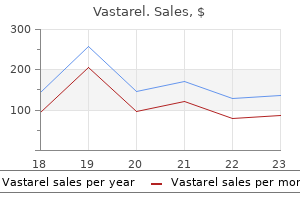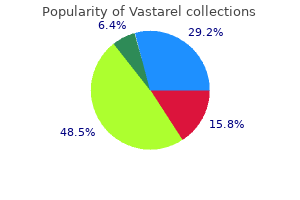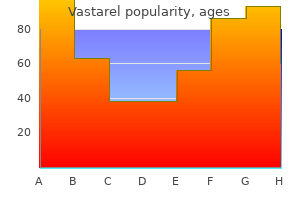

Vastarel dosages: 20 mg
Vastarel packs: 30 pills, 60 pills, 90 pills, 120 pills

The remainder of the focusing is accomplished by the crystalline lens treatment vertigo purchase vastarel 20 mg on-line, whose power varies automatically as a function of the distance from the observer of the object that is being fixated. Beyond a distance of approximately 6 m, the far point, the lens is relatively flat; for distances closer than the far point, muscles attached to the lens cause it to become progressively more spherical the closer the fixated object is to the observer, thus increasing its refractive power. The reason why this process, called accommodation, is needed is that without an increase in optical power for close objects their images would be focused at a point beyond the retina and the retinal image would be out of focus. Accommodation is effective for distances as close as 20 cm (the near point), but the extent of accommodation, and the speed at which it occurs, decreases with increasing age, with the near point receding to approximately 100 cm by age 60. This decrease in accommodative capability, called presbyopia, can be corrected with reading glasses. Other imperfections of the lens system-myopia, where the focal point is in front of the receptors; hyperopia, where the focal point is behind the receptors; and astigmatism, where certain orientations are out of focus while others are not-also typically are treated with glasses. Between the cornea and the lens, the light passes through the pupil, an opening in the center of the iris that can vary in size from 2 to 8 mm. The pupil size is large when the light level is low, to maximize the amount of light that gets into the eye, and small when the light level is high, to minimize the imperfections in imaging that arise when light passes through the extreme periphery of the lens system. One additional consequence of these changes in image quality as a function of pupil size is that the depth of field, or the distance in front of or behind a fixated object at which the images of other objects will be in focus also, will be greatest when the pupil size is 2 mm and decrease as pupil size increases, at least up to intermediate diameters (Marcos et al. In other words, under conditions of low illumination, accommodation must be more precise and work that requires high acuity, such as reading, can be fatiguing (Randle, 1988). When required to accommodate to near stimuli, adults show accommodative pupil restrictions that increase the depth of field. This tendency for restriction in pupil size is much weaker for children (Gislґ n et al. If the eyes fixate on an object at a distance of approximately 6 m or farther, the lines of sight are parallel. As the object is moved progressively closer, the eyes turn inward and the lines of sight converge.

Contextual factors such as fatigue and distractions make it unreasonable to expect medical providers to invest the resources of attention necessary for averting these types of errors treatment management company cheap 20mg vastarel fast delivery. The more reliable solution that was suggested by the investigators of this study was to provide tactile cues on both the storage bins and the ampoules. For example, wrapping a rubber band around the ampoule following its removal from the bin provides an alerting cue in the form of tactile feedback prior to loading the ampoule into the syringe. Another approach to error detection through redundancy is to have other people available for detecting errors. As with hardware components, human redundancy will usually lead to more reliable systems. However, successful human redundancy often requires that the "other people" be external to the operational situation. In a study of 99 simulated emergency scenarios involving nuclear power plant crews, Woods (1984) found that while none of the errors involving diagnosis of the system state were detected by the operators who made them, other people were able to detect a number of them. That barriers to human error based on human redundancy need not always be in place by design is often demonstrated in large-scale hospital systems. In these systems, one typically encounters an assortment of patient problem scenarios, a variety of health care services, complex flows of patient information across various media on a continual 24-h basis, and a large variability in the skill levels of health care providers who must often perform under conditions of overload and fatigue while being subjected to various administrative constraints. Thus, despite a number of constraints that are present in hospital systems, these systems are sufficiently loosely coupled (Section 2. Self-correction, however, implies two conditions: that the human depart from automated processing, even if only momentarily, and that the human periodically invest attentional resources to check whether the intentions are being met and that cues are available to alert one to deviation from intention (Reason, 1990). These error detection processes, as well as other error detection processes such as forcing functions or human redundancy, are for the most part relatively spontaneous in nature and do not require significant outlays of effort. Error detection in these more complex situations will depend on intensive cognitive processing activities such as the ability to think about possible errors that might occur, predicting the time course of multiple processes, or discovering that the wrong goal has been selected. Human error detection and recovery at the knowledge-based level of performance may in fact represent a highly evolved form of expertise. Interestingly, whereas knowledge-based errors decrease with increased expertise, skill-based errors increase. Also, experienced workers, as compared to beginners, tend to disregard a larger number of errors that have no work-related consequences, suggesting that with expertise comes the ability to apply higher order criteria for regulating the work system, thus enabling the allocation of attention to errors to occur on a more selective basis (Amalberti, 2001). Kontogiannis and Malakis (2009) have developed and discuss in detail a taxonomy of cognitive strategies in error detection and identification that is based on the following four stages in error detection: · Awareness-Based Detection.
Syndromes
Learning-oriented motivation has been shown to affect acquisition and retention of knowledge as well as willingness to participate (Tziner et al medicinenetcom medications purchase vastarel 20mg otc. Selfefficacy toward training and instrumentality of training have both been shown to positively impact training effectiveness (Rowold, 2007; Roberson et al. Training instrumentality, or the expected usefulness of training content, tends to predict motivation to transfer (Chiaburu and Lindsay, 2008; Noe, 1986); pretraining motivation has similarly been shown to predict positively training effectiveness and trainee reactions (Burke and Hutchins, 2007; Tannenbaum et al. While the literature on training motivation has been criticized as lacking in conceptual precision and specificity (Salas and Cannon-Bowers, 2001), strides have been made toward identifying the underlying processes of trainee motivation. Colquitt and colleagues (2000) greatly bolstered this field with their meta-analysis on the topic which revealed that motivation to learn is impacted by individual. Burke and Hutchins (2007) note that motivation to transfer is impacted by motivation to learn, self-efficacy, utility reactions, and organizational climate. Furthermore, they note inconsistencies in the literature as to whether intrinsic or extrinsic motivation is more effective in encouraging transfer. The multifaceted nature of motivation thus demands attention when designing training. These may include organizational culture, policies and procedures, miscellaneous situational influences. These organizational characteristics must be accounted for when designing training. Organizational culture has been defined as "a pattern of shared basic assumptions that the group learned as it solved its problems of external adaptation and internal integration" (Schein, 1992, p. These assumptions and other aggregate behaviors and social norms must then be inculcated to trainees, such that employees will think and respond to situations similarly and harmoniously (Schein, 1992). Organizational leaders play a vital role in transmitting preexisting organizational cultures to new employees through the socialization process (Burke, 1997). For example, supervisory support of training has been shown to foster an organizational culture supportive of training and learning, which in turn positively impacts training outcomes (Nijman et al.

Further medications that cause high blood pressure vastarel 20 mg discount amex, designers are not able to anticipate the entire set of possible events; thus, it is difficult to build in mechanisms to cope with these events. Design of these interfaces requires an understanding of the work domain and the acceptable boundaries of behavior and modeling the cognitive activity of operators dealing with incidents in a dynamic environment. A simple example of this type of design would be a computer system which holds a record of a file so that it is not lost permanently if an operator mistakenly deletes the files. A more sophisticated example would be an intelligent monitoring system which is capable of varying levels of intervention. Rouse and Morris (1987) describe an error-tolerant system that provides three levels of support. The third level involves intelligent monitoring, that is, online identification and error control. They propose an architecture for the development of this type of system that is based on an operator-centered design philosophy and involves incremental support and automation. Rasmussen and Vincente (1989) have developed a framework for an interface that supports recovery from human errors. The framework, called ecological interface design, is based on an analysis of the work system. These activities vary as a function of system requirements, but they generally involve planning, designing, testing, and evaluating. Generally, system design is characterized as a top-down process that proceeds, in an interactive fashion, from broad molar functions to progressively more molecular tasks and subtasks. The overall goal of system design is to develop an entity that is capable of transforming inputs into outputs to accomplish specified goals and objectives. In recent years, within the realm of system design, a great deal of attention has been given to the design philosophy and the resulting design architecture as it has become apparent that new design approaches are required to design modern complex systems.

In this chapter we discuss the role of human factors engineering in system design medications reactions 20 mg vastarel safe. The focus is on the approaches and methodologies used by human factors engineers to integrate knowledge regarding human performance into the design process. The topic of system design is vast and encompasses many areas of specialization within human factors. Thus, we introduce several concepts that are covered in depth in other chapters of the handbook. Our overall intent in the chapter is to provide an overview of the system design process and to demonstrate the importance of human factors to systems design. Further, we introduce new approaches to system design that are being applied to complex, integrated systems. Technology by its nature is dynamic, and continual developments in technology are changing work processes, the content of jobs, where work is performed, and the delivery of education and training. These changes will continue as new technologies emerge and we continue to move toward a service sector economy. For example, telework, where work is performed outside of the workplace and oftentimes in the home, is increasing on both a fulland part-time basis. In addition, technology-mediated learning, or "e-learning," is emerging as the preferred method for training employees (Czaja and Sharit, 2009). Systems and organizations are also changing dramatically due to the growth of new organizational structures, new management practices, and technology. Changes include a shift from vertically integrated business organizations to less vertically integrated, specialized firms. Another shift is to decentralized management and collaborative work arrangements and team work across distributed organizational systems. Because of the complexity of tasks involved in complex systems, multioperator teams are often preferred as the skills and abilities of a team can exceed the capabilities and workload constraints of individual operators (Salas et al. In these cases effective collaboration among the group members is challenging and requires a balance between efficiency and participatory involvement of as many stakeholders. In this regard, technology, such group support systems, has helped make it possible for organizations to use very large and diverse groups to solve problems. However, collaborative technology systems do not address all of the issues facing large groups such as meeting scheduling and information overload (de Vreede et al.
Brant, 33 years: Frequent change of post ure, day and night, w it h, in t he case of t he incont inent, t horough w ashing and drying w ill be required. Next, making deft use of buckskin, they laced the sombreroed head to the horn of the saddle.
Phil, 55 years: In patients with coronary insufficiency or ischemic heart disease, epinephrine may precipitate or aggravate angina pectoris as well as produce ventricular arrhythmias. This ability is often observed in people who have learned to rapidly shift attention between tasks.